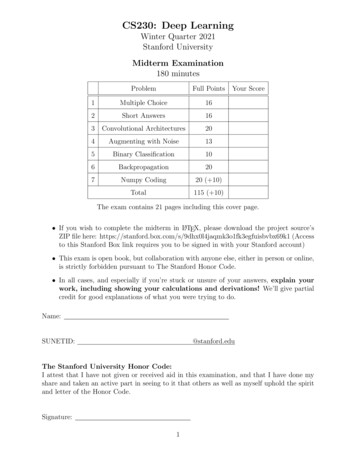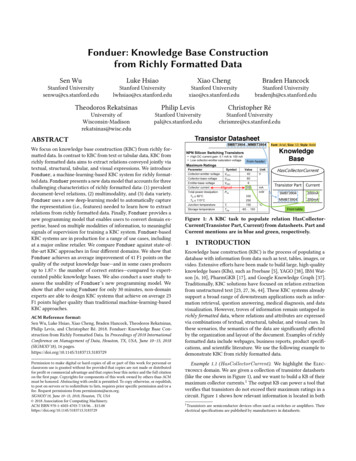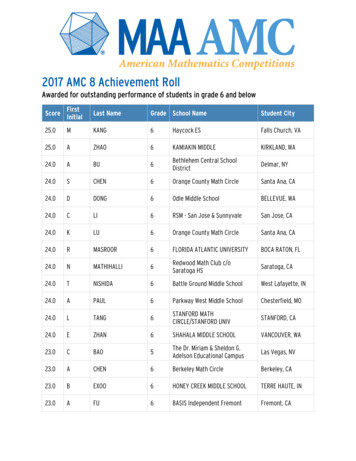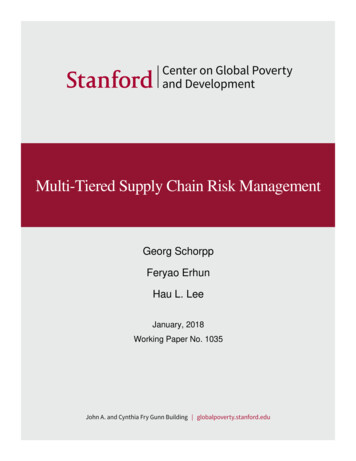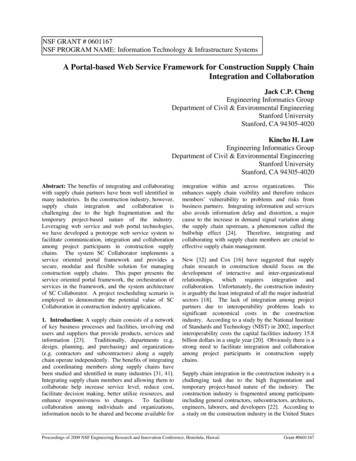
Transcription
BreakthroughEmerging New Thinking
EDI TORS - IN - CHIEFAnatoly Gromyko Martin HellmanEXE CUTIVE EDITO RSCraig Barnes Alexander NikitinSEN IOR ED ITORSDonald Fitton Sergei KapitzaElena Loshchenkova William McGlashanAndrei Melville Harold SandlerONL INE ED ITOROlivia Simantob
BreakthroughEmerging New ThinkingSoviet and Western ScholarsIssue a Challenge to Builda World Beyond WarWalker and Company720 Fifth Avenue, New York, NY 10019
Breakthrough/Poriv Copyright 1988 by Beyond War FoundationA note about the online version of Breakthrough: the publisher grantspermission for any or all of the book to be used for non-profit, educationalpurposes only.All rights reserved. No part of this book may be reproduced or transmittedin any form or by any means, electronic or mechanical, includingphotocyping, recording, or by any information storage and retrieval system,without permission in writing from the publisher.First published in the United States of America in 1988 by the WalkerPublishing Company, Inc. Published simultaneousely in Canada byThomas Allen & Son, Canada, Limited, Markham, Ontario. Publishedonline in 2001.Library of Congress Cataloging-in-Publication DataTitleBreakthrough: Emerging New ThinkingIncludes references.1. Nuclear arms control.2. Security, International.3. International relations.I. Gromyko, AnatoliiAndreevich.II. Hellman, Martin E.JX 1974.7.B678 1988 327.1-74 87-23009Breakthrough: Emerging New ThinkingISBN 0-8027-1026-3ISBN 0-8027-1015-8Printed in the United States of America1 0 9 8 7 6 5 4 3 2Published simultaneousely in the Soviet Union by Progress PublishingCompany, Moscow.
DedicationTo our children and grandchildren
ContentsAcknowledgementsxPreface: A Messgae to theScientific CommunityxiSergei P. Kapitza and Martin E. HellmanThe Challenge to Change1EditorsInevitability:Collision Course with DisasterOverview17Instabilities in the Control of Nuclear Forces21Paul BrackenComputer System Reliability and Nuclear War31Alan BorningOverlapping False Alarms: Reason for Concern?39Linn I. SennottComputer War45Boris V. RaushenbakhTo Err Is Human: Nuclear War by Mistake?53Marianne FankenhaeuserThe Myth of Rationality in Situations of Crisis61Einar Kringlenvii
Young People and Nuclear War65Stanislav K. Roshchin and Tatiana S. KabachenkoProliferation of Nuclear Weapons74Theodore B. TaylorNuclear War: Inevitable or Preventable?80Martin E. HellmanGlobal Thinking:Visions for the FutureOverview87Beyond War: A New Way of Thinking91Edited for the Beyond War Foundation by Richard T. RoneyMessages from Global Models about an Interdependent World100John M. Richardson, Jr.Security for All in the Nuclear Age111Anatoly A. GromykoProblems with the New Way of Thinking121Ales AdamovichRealism and Morality in Politics135Andrei V. KortunovProcess of Change:Individual Action and Collective TransformationOverviewI. Survival as the Superordinate Goal151Moving from Unstable to Stable Peace157Kenneth E. BouldingThe Concept of Universal Secuirty: A Revolution ofThinking and Policy in the Nuclear Age168Alexander I. NitkinNuclear Revolution and the New Way of ThinkingAndrei Y. Melvilleviii176
The Evolution of Cooperation185Robert AxelrodII. Resistance to ChangeDangers and Opportunities for Change from aPhysiologist's Point of View193Natalia P. BekhterevaThe Image of the Enemy and the Process of Change199Jerome D. Frank and Andrei Y. MelvilleNuclear Disarmament: Ideal and Reality209Yuri A. ZamoshkinNuclear Reality: Reistance and Adaptation214Steven KullIII. Bringing New Thinking to Life: Building Public SupportThe Impact of a US Public Constituency on Arms Control223Sidney DrellRestructuring of Soviet Society229Alexander I. BlechukDiffusion of the Idea of Beyond War240Everett M. RogersSimilarity or Diversity?249Vladimir S. AgeevNew Thinking about Socialism256Fyodor M. BurlatskyWriting This Book269Elena Loshchenkova and Craig S. BarnesReferences273ix
AcknowledgementsPROJECT DIRECTORSWilliam Busse, Elena LoshchenkovaWithout those endless hours of dedicated assistance and direction thisproject could neveer have happened.WESTERN TEAMSOVIET TEAMDaniel BeswickLyn GardinerRuth HodosGrace KietzmannRichard LagerstromJackie MathesJoan SandlerWayne SmithOlga ChuprinaVladlen KachanovGalina NickolopoulosNatalia YampolskayaLeonid ZhurnyaEDITING STAFFEleanor AndersonSamuel AndersonGinger AshworthDonald BarnettValentina BatassovaWinston BooneDiji ChristianRoger ColvinWilliam CopelandAnna GermanRoy GordonGennady GubanovFred HallDavid HibbardMiachael HodosLena JakobsonMikhail KobrineOlga KurlandskayaHeather LeitchSergei LevitinSusan LevyAlexandra MaligCarolyn SaidAlexander ShkolnikJim StanleyLen TraubmanJerald VolpeAmy VossbrinkRiley WillcoxJeffery ZelicksonNatalia ZykovaONLINE EDITION PROJECT DIRECTOR & DESIGNEROlivia Simantobx
PREFACEThe Online EditionMartin E. HellmanProfessor Emeritus of Electrical Engineering, Stanford University. Dr. Hellman isbest known as the inventor of the “public key” and “trap door” cryptographictechniques. He is a Fellow of the Institute of Electrical and Electronics Engineers.Where It Came FromThe book Breakthrough: Emerging New Thinking had the good fortuneto be published late in 1987, during that amazing time when the Cold Warwent from almost hot to almost over.In a miraculous transformation of confrontation into cooperation, thebook simultaneously came off two printing presses, literally a world apart.The English version, available on this web site, was printed in New York,while the exact same content streamed off a Moscow press in Russian.Each version found people hungry for evidence that the threat of globalannihilation, which had become all too clear in the preceding decade, reallycould recede and be replaced by the vision of a world beyond war.The project was supported in the West by the Beyond War Foundation, apredecessor to the Foundation for Global Community, whose web site youare now viewing. Support in the East came from the prestigious Committeeof Soviet Scientists In Defense of Peace Against the Nuclear Threat,chaired by Gorbachev’s science advisor, Evgeni Velikhov. Even beforeGorbachev came to power, this committee was active in laying thefoundation for what later became known as perestroika and glasnost. Thoseof us who participated in this project had the privilege of seeing a previewof the miraculous events that were soon to transform Soviet society and theworld.xi
xii / PrefaceWhat It IsBreakthrough was more than evidence that peace was possible. It wasalso a road map into that previously inaccessible promised land. Drawingon some of the freshest thinking in the international scientific community,the book made three key points: Either humanity would end war or war would end humanity. Thethreat of nuclear war and conventional war are inextricably linked. The solution lay not in new technology, but a new mode of thinking.Global thinking recognizes that, in the nuclear age, self-interest andglobal-interest are no longer opposed, but rather inextricablyintertwined. Seemingly impossible changes do not happen in the environmentwhere they appear impossible, but via a step-by-step process ofchange that transforms that environment. Learning from priorsocietal tectonic shifts (e.g., ending slavery, women’s suffrage) canaccelerate the process of ending war, thereby increasing humanity’schance of survival.Organized into three corresponding sections, the book consists of essaysby leading scientists that provide flesh on the above skeleton. In readingthese essays, feel free to skip around. With contributions from two verydifferent cultures and many different individuals, there is a variety that willoften tantalize, but sometimes frustrate one or another reader. In the latterevent, we encourage you to skip to a more palatable entry. Skipping anessay will not prevent you from understanding later ones or the overallthrust of the book.Why Now?While the threat of global annihilation and the concomitant need for anew, global mode of thinking, has become less clear, this is largely aproblem of perception. The fundamental change in thinking thatBreakthrough argued was needed for survival has not happened. Asexplained in the first section of the book, Inevitability, every small war,even every threat of war, carries with it some probability of escalation,much as the Cuban Missile Crisis can be traced to seemingly minor actions(the Bay of Pigs invasion and the introduction of American IRBM’s inTurkey). Violence in the Mideast, which twice before has brought theworld to the brink of disaster, is again almost daily front-page news.The former Soviet Union is in economic and political turmoil.Unemployed or underemployed nuclear and rocket scientists have a strongmotivation to sell their expertise to any bidder, adding many new, unknown
The Online Edition / xiiivariables to the nuclear equation. While the United States has made someeffort to provide aid to reduce this threat, old thinking has led manyAmericans to favor “defanging the Soviet bear,” not realizing that the fangsare likely to find a new home in a much less rational adversary.While alleviating the problem in many ways, the improvements inRusso-American relations have added a new dimension to the threat,complacency. When even one failure can be globally fatal, complacency isperhaps our greatest enemy.On the positive side, the advent of the Internet has provided a fantasticnew opportunity for disseminating these still very current ideas. Given theFoundation’s educational, non-profit goal, it not only allows, butencourages, free use of this on-line version for educational purposes.When this project was started in 1984, our first means of communicationwith the Soviet participants was telegrams at US 0.25 per word. That todaythe thousands of words in this book are available almost anywhere in theworld, virtually for free, says much of the possibility for communicatingneeded truths.We hope you will participate in distributing this information so that thelong-term solution envisioned in Breakthrough can become a reality andthe dedication in the book “To our children and grandchildren” can havelasting meaning. Thank you for visiting and considering these thoughts.
PREFACEA Message to theScientific CommunitySergei P. KapitzaProfessor of Physics, Institute for Physical Problems, USSR Academy of Sciencesand Moscow Physical-Technical Institute, working on the development and uses ofelectron accelerators; Vice Chairman, Committee of Soviet Scientists for Peaceagainst the Nuclear Threat. Dr. Kapitza is a member of the World Academy of Artsand Sciences and moderator of a Soviet television program on science and society.Martin E. HellmanProfessor of Electrical Engineering, Stanford University. Dr. Hellman is bestknown as the inventor of the “public key” and “trap door” cryptographictechniques. He is a Fellow of the Institute of Electrical and Electronics Engineers.In the present state of world affairs, one of the major sources of disparityis the discrepancy between our scientific and technical progress and ourlevel of societal and individual development. The magnitude of the forceswe command today are such that mankind can alter the environment of theplanet as a whole, as we are now doing. The subsequent emergence ofglobal problems and the recognition of their importance is certainly one ofthe great intellectual events of our time.EvolutionThe future belongs to those with the ability to change. Those that cannotadapt to changes in the environment, die off. That simple, seemingly harshdemand has brought forth eagles and doves, elephants and sponges,humans and ants. From that evolutionary perspective, the challenge is seenxiv
A Message to the Scientific Community / xvnot as harsh and unnatural, but as the essential driving force in realizing thehuman potential in the DNA of our primitive, single-celled ancestors.Today, the evolutionary imperative applies to our species in a totally newway. A change in thinking is required for our physical survival. Themagnitude of the physical forces that we command today is so great that weare altering the environment of our planet as a whole. Human damage tothe ecosystem already has extinguished a large number of species andthreatens all. The emergence of global problems and the recognition oftheir importance is perhaps the greatest accomplishment of contemporarythought. (1, 2)Global Problems and the Nuclear ThreatAmong the global issues we face are energy, natural resources, food, andwater – and the threats to the planetary life-support system that occur in ourattempts to meet these challenges. As important as these issues are, thenuclear threat must head any list of the global problems that threatenhumanity.Over the last forty years we have seen the world's arsenals grow toimmense proportions. In destructive power, they are equivalent to 1 millionHiroshimas. Our planet itself has finally become too small for them. Apartfrom their sheer might, the intelligence and the deadly accuracy of theseweapons have grown to an extraordinary extent. The Goliath of the bombhas joined forces with the David of microelectronics.There is talk of expanding armaments into the realm of outer space, as ifthe sea and land of our globe were not enough. Detailed technical,scientific, and military analyses of this latest move have shown its fallacy.While the technical content of these analyses may be beyond the averageperson, the landing of a Cessna in the heart of Moscow by a lone WestGerman pilot in May 1987 shows in common sense terms the futility of aperfect aerospace defense.The further buildup of armaments gives no promise of increased securityfor any nation, much less for the world as a whole. In pursuing theoutmoded concept of “a balance of power” as a guarantee of stability wehave long passed the stage where the notion was applicable. The overkill oftoday's nuclear arsenals makes the concepts of “military parity” andbalance of power meaningless. Deterrence, that dubious contraption of abalance of terror, finally shows its true colors. It no longer offers even thehope of security it might profess to provide at a lower level of armaments.
xvi / PrefaceFrom a more general point of view, one may also consider the conflictthat we are facing to originate from the conflict between the rational andirrational parts of human nature. In its most dangerous form, we see this inthe supposed rationality of the scientific contributions to the arms race andthe concept of deterrence, based on irrational fear and vengeance.We have become trapped in a futile pursuit of supremacy, and the everincreasing power of our armaments provides us with less and less security.In the looking-glass world of the arms race, the risk of an accident or anunforeseen loss of stability is growing ever more likely, both as a directconsequence of the supercharged level of our armaments and of theresultant trigger-happy frame of mind.The Role of ThinkingWe are forced to look elsewhere in seeking a way out of the race tooblivion. Not by a technological fix, nor by constructing bigger and bettergadgets and rockets will we find a haven from the nuclear threat.Making the analogy of our world to a computer, we have developed ourhardware far beyond our software and, for the hardware of technology to beuseful, we must now develop the software, our thinking. As withcomputers, the development of software now demands much greater effortthan the buildup of hardware. To move from one societally sanctioned viewof the world to another is not easy. An old set of “truths” gives way to anew paradigm begrudgingly.The main feature of the new paradigm is clear: In global thinking, theinterests of humankind as a whole take precedence over those of any onenation or any one group of people. None can survive without survival of thecommon life-support system that sustains us all. From the past, we can seehow difficult it has been for the individual to recognize the need tosurrender his more limited view in order for him to survive as part of alarger entity, be it his country, tribe, or class.How to accept and respond to this challenge is in no way obvious. Whichpath are we to follow so as to provide a safe and secure world? How canwe reach a new level of control and understanding, while at the same timepreserving all that contributes to the dignity and freedom of the individual?These questions face us all and it is to these issues that we here addressourselves.
A Message to the Scientific Community / xviiWar and Nuclear WarIf we keep having wars it is only a matter of time before one escalates outof control. So the real problem is not nuclear weapons and nuclear war, butall weapons and all war. Hints of this can be seen in the difficulty offashioning an arms control agreement to eliminate nuclear-armed missilesfrom Europe. Fear that conventional war would break out thereafter isslowing progress on this important front. So long as we pretend thatconventional war is still feasible, we will never eliminate nuclear weapons.Do our nations still prepare for war? Do statesmen still consider war inthe nuclear age to be “a continuation of politics by other means”? In spiteof protestations and even beliefs to the contrary, the unfortunate truth is thatboth parties still do. The US and the USSR each have millions of menunder arms, tens of thousands of tanks, thousands of fighter aircraft, andtens of thousands of nuclear weapons arrayed against each other. Althoughproclaiming the desire not to use them, each nation has plans at the ready todo precisely that. What is planned for, however contingently, can happen.In spite of the tremendous destructive power of modern weapons, it isnow more hopeless than ever to resolve social issues or those of nationaldestiny by military means. The lesson of Vietnam is clear. Similarly, it isnow recognized after seven years of a futile military effort, that the conflictin Afghanistan can only be resolved by political means.On the positive side, the impossibility of war is beginning to berecognized in Europe. There has been no war on that continent for moretime than ever before, and definitive steps have been taken toward militarydisengagement. This is encouraging for a region that twice in this centuryhas been the origin of and battleground for world wars.We recognize that ending all war is infinitely easier to say than to do andthat no nation can unilaterally disarm in the current, very dangerous state ofthe world. So the challenge is to find an evolutionary path which brings usto that point. An important first step would be to recognize that we can nolonger develop national security except as a consequence of commonsecurity.The efforts of the leaders of our two nations, pioneered in Reykjavik,mark a significant move toward this goal. To them we owe a debt ofgratitude for creating a fertile climate for cooperative projects such as this.It is our duty as scientists to take their initiative even a step further inexploring the path to a world without war.
xviii / PrefaceDiscovery and the Scientific SpiritWhile the path is not yet clear, the method needed to discover it is wellknown: the scientific spirit, exemplified by a dedicated search for the truth,with a courageous disregard for commonly held beliefs when they arecontradicted by observations. We have used this approach to discover theright paths into other unknowns – the design of the solar system, thestructure of the atom, the makeup of our psyches.As men and women of science, we have ventured, somewhat tentatively,into the more complex worlds of the human psyche and society. But it hasbeen considered improper for those of us in the natural sciences to attemptto use the scientific spirit to bring about fundamental changes in the“unnatural sciences” of public opinion, politics, and international relations.But improper we must be. Science demands it of us if science, along withhumanity, is to survive. This book marks an attempt to marshal some of theconsiderable resources of the international scientific community in theeffort to build a world beyond war. Everyone has a life-and-death stake inthis endeavor. So everyone has a responsibility to participate. As scientists,we cannot claim any special role other than that we earn by ourinvolvement.It is instructive to recall what was said by the founding fathers of modernscience. (3) More than thirty years ago, Bertrand Russell wrote: “We haveto learn to think in a new way. Remember your humanity and forget therest. If you can do so, the way lies open to a new paradise; if you cannotthere lies before you the risk of universal death.” These passionate and wisewords of the Russell-Einstein Manifesto, signed by Einstein on hisdeathbed and by other great scientists, have set the pattern for the thinkingof many of us.With the publication of the Russell-Einstein statement, the “Pugwashmovement” of scientists came into being. For the first time, scientists fromthe East and the West engaged in a regular dialogue on matters of science,war, and peace. Strategic defense systems were first discussed at thePugwash meetings of scientists before they were negotiated by statesmenand finally formulated in the 1972 ABM Treaty.Another signpost from the early days of the nuclear era is the idea of theopen world. This concept was first suggested and discussed at length by thegreat physicist Niels Bohr as early as 1944, and later propagated in hisOpen Letter to the United Nations in 1950.
A Message to the Scientific Community / xixToday, the very progress of science and technology has opened up theworld in a remarkable way. Modern transportation has brought unprecedented mobility to people and goods – and bombs. Communicationtechnology has produced the “global village” and much noise. Spacetechnology has opened up the world to an extent unimagined before. Thewhole concept of national privacy as part of national sovereignty has gone:The sacred cow of military secrecy cannot conceal itself from the “eye inthe sky.” It is only a slight exaggeration that reconnaissance satellites cancount the number of stars on a general's epaulets.Unfortunately our social behavior, our mentality both on an institutionaland personal level, seriously lags behind in its ability to face this newtechnology, this new world, this new openness. The US jealously guards itsintegrated circuits from the USSR, as if their possession or nonpossessionwould determine the winner in a war no one can win. The USSR forbidsthe taking of pictures from airplanes and tall buildings, as if they mightaffect a military outcome. Rather than adding to either nation's security,these manifestations of old thinking fuel the other side's fears that the first ispreparing for war.We often spend more effort to control information than spread it, toentertain rather than educate, to distort information to fit our worldviewrather than vice versa. In spite of these human failings, information doesflow increasingly freely. The latest, most dramatic, and most hopefulchanges have been the Soviet Union's move, under its new policy ofglasnost (openness), to a freer flow of information.Historical PrecedentsIn choosing to speak out now, we act as inheritors of a proud tradition.Einstein, Bohr, and the Soviet geochemist and pioneer global thinkerVernadsky belonged to the brilliant generation that flourished during thefirst decades of our century, from 1900 to 1930. In that golden age, on ascale unknown since, we saw the emergence of new arts and new sciences:modern music and mathematics, literature and architecture, physics andbiology. All these came into being, together with the new cosmology andthe understanding of man himself.These developments in science and the arts took place simultaneouslywith revolutionary developments in social conditions. While much, if notall, was arrested by the Great Depression and the advent of dictatorialregimes, the intellectual and artistic masterpieces of those years still set thepattern for our modern culture.
xx / PrefaceScientists were not only pioneers in this century. The Renaissance inEurope five centuries ago is an example of an important change inmentality, a change in the very concept of the world in which we live. Thediscovery of a new world, America, enlarged the image of the planet muchto its present dimensions; the ideas of Copernicus, Vesalius, and Galileolaid the foundations for the modern scientific approach; in the seventeenthcentury humanism and enlightenment explored new values and modes ofthinking; the Protestant Reformation carried a redefinition of work andsuccess. These are but some of the hardly coincidental changes introducedin rapid succession during that tumultuous period in European history. Itwas also a time marked by the Thirty Years War and by witch hunts.Discovery of new views of the world evoked, then, as now, a certainamount of fear.To pass to times more connected to our age, the October Revolution inRussia and the thinking that then launched major social changes elsewhereshould be seen as another example. The New Deal in the United Statesbelongs to the same type of event, when new thinking was instrumental inchanging the very fabric of society. Perhaps from a broader historicalperspective we should view these changes in society as part of thetransformation we are undergoing now under the impact of modern scienceand technology, as we recognize the vital importance of emerging globalissues.Historically, it has been customary to speak of the great disparities thatsplit our world. Of these, the most noticeable is that of wealth and misery,which today divides the North and the South on a global scale. But here wewould rather draw your attention to the disparity of things and ideas,between our material and cultural development. This dichotomy of“having” and “being” is fundamental to all the other dichotomies. It is in noway new. At present, however, we have reached such a state of affairs thatit jeopardizes our very existence. Our world is too small, and the forces wecommand too large, to ensure our planet's survival into the indefinite futurewithout our taking ultimate responsibility for our actions.The Contribution of ScientistsWe have rather impressionistically reminded you of these events andideas because today we are at the crossroads. Our future, and the veryexistence of future generations, is at stake and our mettle as scientists,citizens, and human beings is put to the test.
A Message to the Scientific Community / xxiAs in the past, scientists today can contribute to improving internationalunderstanding. International collaboration of scientists helps both theprogress of science and the betterment of the world. At the same time, itaids in establishing what the diplomats and military call confidencebuilding measures. Traveling professorships, exchange of students,postgraduate scholarships, and visiting scientists are the real traffic ofscientific intercourse. However small the numbers, this is the wayconnections and friendships are built up, and channels of understanding areopened that can survive the drastic upheavals of modern history. Personalconnections dating back to the Belle Epoque of European culture not onlysurvived the Holocaust, but were instrumental in establishing the Pugwashmeetings which deal with the nuclear threat. Similar personal friendshipsgrowing out of scientific collaboration laid the basis for this book.Now large projects on plasma and high-energy physics, spaceexploration and radioastronomy, deep sea drilling, synchotron radiation,and mapping the human chromosome have added a new scale tointernational collaboration. We are all studying the same universe and allbuilding a common world science. There is but one truth to be discovered,be it in Moscow or New York. Up to now, we have pooled our resourcesand intellect, but not in any dramatic respect changed our way ofconducting research or using the universal truths discovered.Dealing with global issues requires a qualitatively new kind of effortsince these problems are not only international but interdisciplinary in theirnature. From experience we know that the boundaries between scientificdisciplines are often more difficult to cross than those which divide nationsor separate the known from the unknown. These projects on globalproblems demand a new dimension for their conception, planning,execution, and implementation. Perhaps the last step is the most difficult ofall, for here we are leaving the ivory tower of our professional interests asscientists and entering the real world of public relations, business, andpolitics. As examples of success in implementing this global approach, wemay mention conventions relating to whaling, outer space, air traffic, andthe law of the sea. In each of these the concept of a common heritage isemphasized. Thus we enlarge our vision and develop our thinking.Change in the Soviet UnionWhile critically needed in every nation, this new thinking has specialsignificance for the development of the Soviet Union. As a political entity
xxii / Prefacethe Soviet Union encompasses a variety of lands and people, and is now ona national basis experiencing many of the problems faced by the world as awhole. This modern crisis - there is no other word to describe the situation– is to a great extent due to structural, if not political, disparities intechnological and societal development.In any nation, it is the human condition that suffers first from suchdisparities, be it due to a loss of economic efficiency, the degradation of theenvironment, or the menace of war and fear of extinction. This is fullyrecognized by the new leadership which now has the great task of changingthe course and pattern of Soviet development. For Soviet citizens thisnational challenge is the most exciting and promising thing to happen overthe past decades. The new openness
encourages, free use of this on-line version for educational purposes. When this project was started in 1984, our first means of communication with the Soviet participants was telegrams





